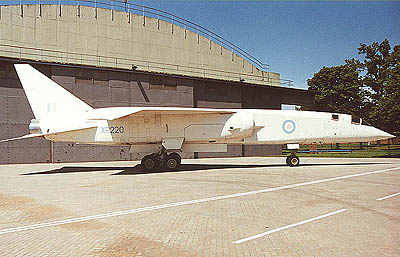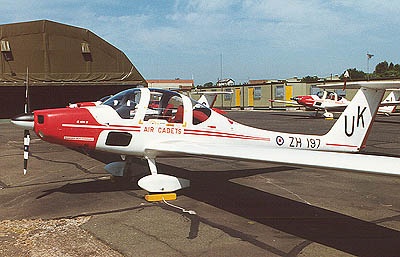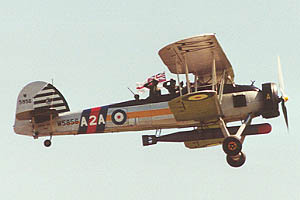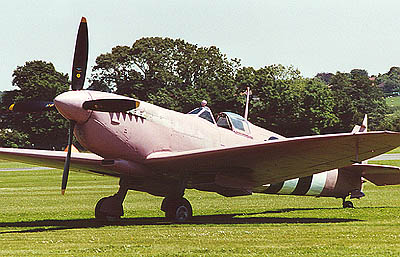| The heat is on... RAF COSFORD AIRSHOW 2000, 18 June
 Andrew Bates mops his brow to report that midway through June,
the UK finally welcomed the arrival of summer (albeit briefly), seeing a very welcome rise
in temperature and some beautiful clear blue skies. This year's airshow at RAF Cosford,
held on what may subsequently prove to be the hottest day of the year, saw a very large
influx of visitors descend on this part of Shropshire. Taking full advantage of the
weather, many people had obviously come prepared, with a proliferation of sun loungers,
parasols, and even barbecues appearing in the car parks, which had began to fill very
shortly after the gates were opened. Andrew Bates mops his brow to report that midway through June,
the UK finally welcomed the arrival of summer (albeit briefly), seeing a very welcome rise
in temperature and some beautiful clear blue skies. This year's airshow at RAF Cosford,
held on what may subsequently prove to be the hottest day of the year, saw a very large
influx of visitors descend on this part of Shropshire. Taking full advantage of the
weather, many people had obviously come prepared, with a proliferation of sun loungers,
parasols, and even barbecues appearing in the car parks, which had began to fill very
shortly after the gates were opened.
Not surprisingly, the event was well supported by the RAF, with an example of almost every
type in the inventory participating in the flying display, intermingled with a number of
'imported' airshow participants. Meanwhile, the static display followed Cosford's
traditional format of visiting aircraft and selected airframes from 1 SoTT, supplemented
by all the RAF Museum inhabitants, the admission charge for which is always inclusive of
the airshow ticket price.
By way of a change from previous shows, the main static park for all visiting aircraft was
positioned away from the hangars, and was on a hardstanding in the middle of the airfield,
an area usually reserved for car parking during show day. Within this area was a selection
of helicopters, along with a few fixed wing aircraft, and generally this new feature was
well received by the enthusiasts, with most of these airframes being well spaced for
photography.
Within this static park, a first time visitor attracting much attention by way of its
impressive size, was RN Merlin HM1 ZH838, whilst RAF 18 Squadron
Chinook HC2 ZD981/BI proved equally as popular. Other rotary winged visitors included a
pair of 847 Squadron machines from Yeovilton; Lynx AH7 XZ612 and Gazelle AH1 ZB676, whilst
the DHFS at nearby Shawbury provided Squirrel HT1 ZJ260 and Griffin HT1 ZJ241. Dutch
participation was forthcoming once more, which saw KLu Bo105CB B-70 parked alongside MLD
SH-14D Lynx 276.
 The fixed wing element of the main static simply comprised of two visitors; 1
FTS Tucano T1 ZF449 and RN 750 Squadron Jetstream T2 XX481/560, along with home based BUAS
Bulldog T1 XX670/C and 633 VGS Vigilant T1 ZH206/UM. Just a short walk away from this
static display was the 633 VGS hangar, where they had gone to the trouble of bringing
their four remaining Vigilants out into the sunshine, forming a small static park of their
own. Obviously not the most exciting of military aircraft to photograph, but the effort
was greatly appreciated. The fixed wing element of the main static simply comprised of two visitors; 1
FTS Tucano T1 ZF449 and RN 750 Squadron Jetstream T2 XX481/560, along with home based BUAS
Bulldog T1 XX670/C and 633 VGS Vigilant T1 ZH206/UM. Just a short walk away from this
static display was the 633 VGS hangar, where they had gone to the trouble of bringing
their four remaining Vigilants out into the sunshine, forming a small static park of their
own. Obviously not the most exciting of military aircraft to photograph, but the effort
was greatly appreciated.
One traditional feature of any Cosford show is the
Museum's policy of taking a few selected airframes out of the hangars and placing them on
outside static display. Past events have seen a varied selection of exhibits see daylight
once more, with aircraft such as Buccaneer, Devon, P-47 or Twin Pioneer removed from the
confines of the Museum, although barrier positioning has tended to make photography a bit
of a challenge in many cases. However, this year the organisers excelled themselves. They
selected research and development as their theme, which saw some rare and unique aircraft
out in the sunshine, and this time some thought had gone into barrier positions, much to
the delight of all the photographers present.
So, Saro SR53 XD145 was parked alongside Hunting H126 XN714, the
sleek, all white SR53 contrasting starkly against the ungainly, all yellow H126, due to
the differing research projects they were both originally designed for. Another pairing
consisted of Bristol 188 XF926 and BAC TSR2 XR220, both of which
proved to be especially popular, if the almost constant click of camera shutters was
anything to go by. Seeing them out in the open enabled a better appreciation of their
unique design qualities. The gleaming, stainless steel 188 provided faint  reminders of the SR71 from certain angles, but even this impressive looking
machine seemed somewhat overshadowed by the sheer size of the TSR2. Even today, this
magnificent aircraft doesn't appear dated, leaving the thought of what might have been,
had the project not been cancelled so drastically during the mid-sixties. reminders of the SR71 from certain angles, but even this impressive looking
machine seemed somewhat overshadowed by the sheer size of the TSR2. Even today, this
magnificent aircraft doesn't appear dated, leaving the thought of what might have been,
had the project not been cancelled so drastically during the mid-sixties.
The remaining static consisted of a number of training airframes from the resident 1 SoTT.
This comprised of Jaguars, Dominies and Jet Provosts, though
regrettably, little or no thought had gone into their display. The collection of Jaguars
were reasonably spaced, but were very close to the barriers, with the Dominies tightly
parked behind them. Meanwhile, the majority of the JPs appeared as if they had almost been
thrown together in a corner, with most retaining a cover over the cockpit. Whilst it is
appreciated that we've all seen Jags and JPs many times before, it seems a shame that the
home fleet couldn't have been given a little more prominence during the organisation of
the static, especially as the 1 SoTT fleet is probably the main attraction for many
enthusiasts. Further examples of Jaguar were available for inspection within a hangar
display, complete with the customary example on jacks performing the usual demonstration
of undercarriage retraction and other hydraulic movements.
The flying display was, as ever, opened by a fine performance from the Falcons parachute
display team, who were able to conduct their normal high altitude descent, thanks to the
superb weather. It certainly made a refreshing change to watch their canopies floating
down through a clear blue sky! Once their support Hercules had landed at Cosford, the
crowds were treated to a fast and thunderous demonstration by 56(R) Squadron's  elusive Tornado F3 ZE339/AZ, resplendent in its Firebird colour
scheme, which had reportedly been frowned upon by the AOC of Strike Command. Whether this
may have accounted for its non-appearance on the airshow circuit is open to conjecture,
but hopefully further appearances may now happen. elusive Tornado F3 ZE339/AZ, resplendent in its Firebird colour
scheme, which had reportedly been frowned upon by the AOC of Strike Command. Whether this
may have accounted for its non-appearance on the airshow circuit is open to conjecture,
but hopefully further appearances may now happen.
The flying programme certainly proved to be a showcase for the RAF, with subsequent
demonstrations from a 1 FTS Tucano T1, 20(R) Squadron Harrier GR7, KMW Nimrod MR2, 16(R)
Squadron Jaguar GR3 and 15(R) Squadron Tornado GR1. Not surprisingly, from the selection
of frontline types, the Harrier proved once again to be the popular favourite with the
crowd.
Continuing the RAF theme, one unusual display item demonstrated the combination of old and
new together as a BUAS Bulldog T1 flew with its planned successor, a CFS Tutor. The Tutor
certainly appeared to possess a more sprightly performance than the Bulldog during
take-off, though the aerobatic qualities looked to be evenly matched. The Bulldog landed
after a relatively short time, leaving the Tutor to display its aerobatic capabilities to
the full, a task which it performed admirably.
Apart from a scintillating performance from the OFMC Hunter F58 J-4090/G-SIAL, which was
immediately followed by the aerial precision of the Blue Eagles, the remaining individual
displays comprised mainly of warbirds. The pistons were kicked off in fine style by TFC
Spitfire VB EP120/G-LFVB, whilst flying the flag for the Navy, literally, was RNHF
Swordfish II W5856.
 The Real Aeroplane Company from Breighton supplied a classic duo with
Hurricane XIIB BE417/G-HURR and Spitfire PRXI PL965/G-MKXI. During last year's airshow
season, this popular pairing were unofficially referred to as 'the Black and Blue pair',
in deference to their individual colour schemes. However, this season, if this tradition
were to be repeated, then they would be referred to as 'the Black and Pink pair'. Yes,
pink! This is not a spelling mistake, the Spitfire had been repainted pink, but before all
the purists start raising their hands in horror, it should be noted that this is actually
an authentic scheme. Some PR Spitfires were indeed painted pink during the war, a scheme
that apparently provided good camouflage below cloud cover. This is certainly an unusual
and imaginative colour scheme, which stands out from all the usual wartime camouflage
schemes associated with the Spitfire. The Real Aeroplane Company from Breighton supplied a classic duo with
Hurricane XIIB BE417/G-HURR and Spitfire PRXI PL965/G-MKXI. During last year's airshow
season, this popular pairing were unofficially referred to as 'the Black and Blue pair',
in deference to their individual colour schemes. However, this season, if this tradition
were to be repeated, then they would be referred to as 'the Black and Pink pair'. Yes,
pink! This is not a spelling mistake, the Spitfire had been repainted pink, but before all
the purists start raising their hands in horror, it should be noted that this is actually
an authentic scheme. Some PR Spitfires were indeed painted pink during the war, a scheme
that apparently provided good camouflage below cloud cover. This is certainly an unusual
and imaginative colour scheme, which stands out from all the usual wartime camouflage
schemes associated with the Spitfire.
Another participant to display new colours was Duxford based Blenheim G-BPIV, which had
forsaken its previous scheme as L8841/QY-C, and was now sporting 1940 era camouflage and
82 Squadron markings as R3821/UX-N. This choice was probably influenced by the decision to
position the Blenheim in the new Battle of Britain exhibition at Duxford in-between its
display commitments.
As ever, the flying programme at Cosford was concluded with another fine display from the
Red Arrows, which saw the Reds take full advantage of all the clear blue sky available to
them. Once the show was over, it was no surprise, given the weather, to see that a good
many people had remained on the airfield to continue perusing the vast selection of
stalls, or to enjoy an evening picnic, and who could blame them. Considering the
lacklustre summer so far, it made a very pleasant change to be able to attend a UK airshow
in shorts and tee-shirt!

|